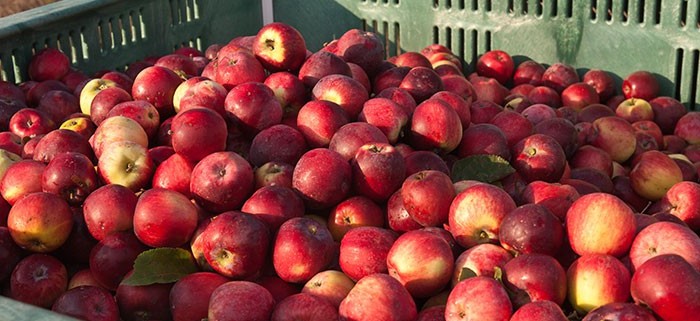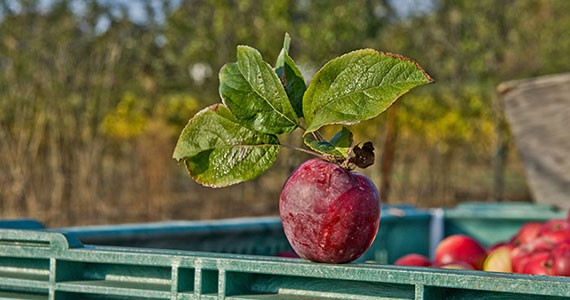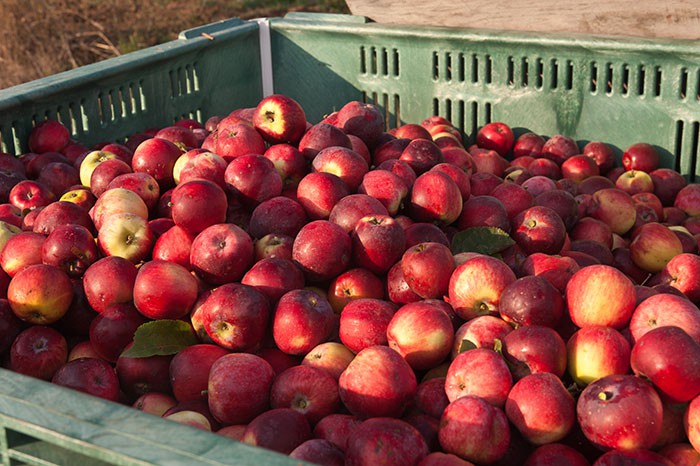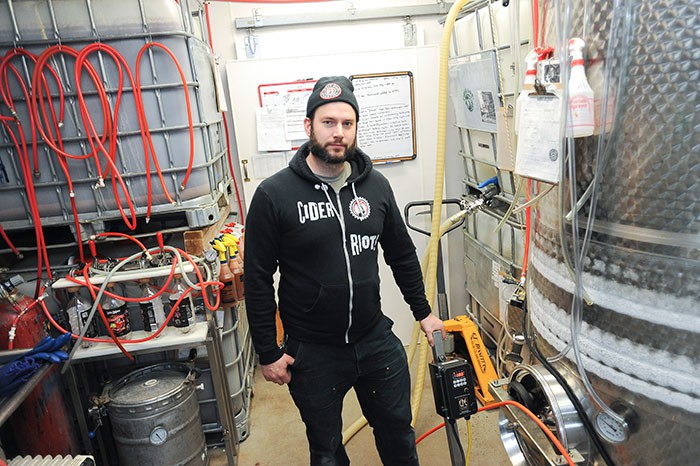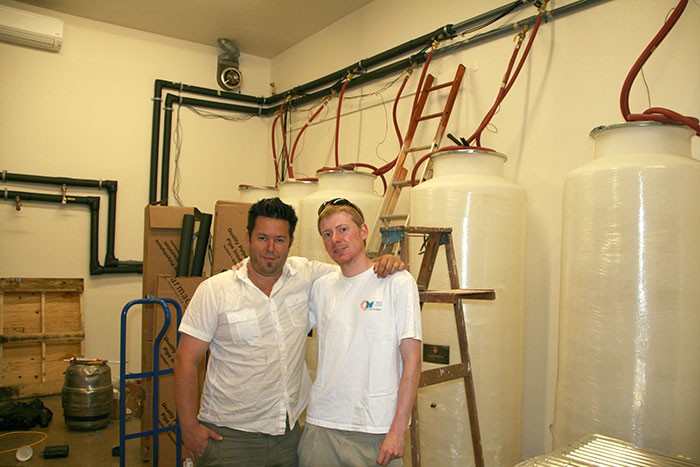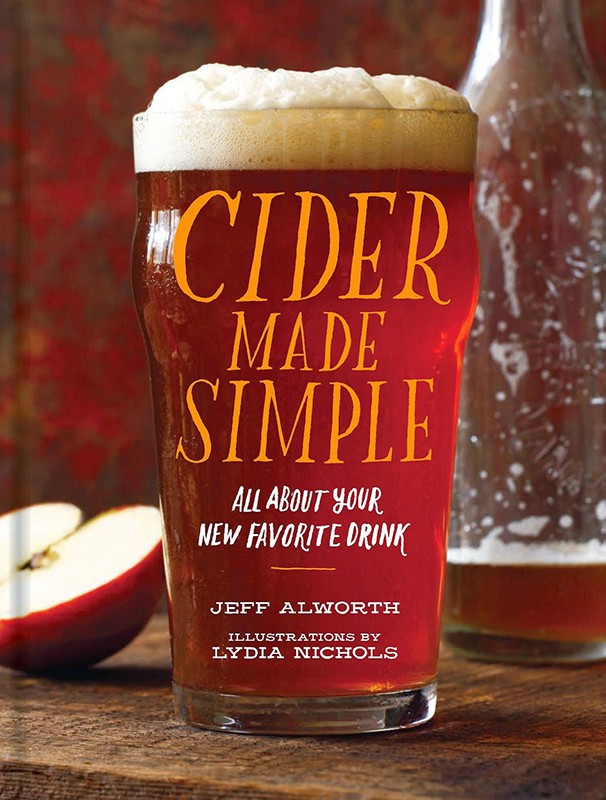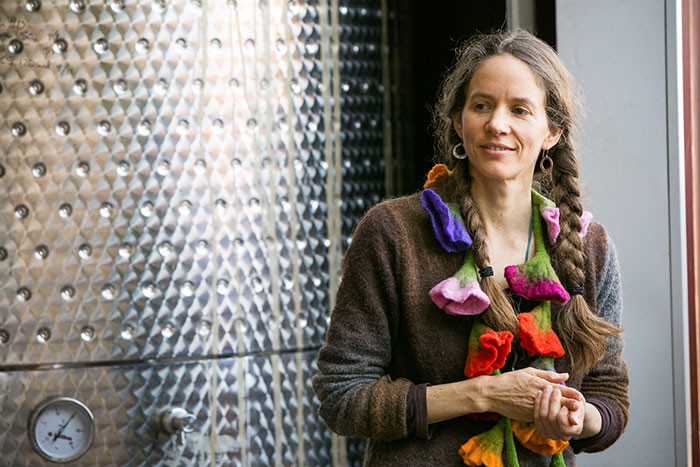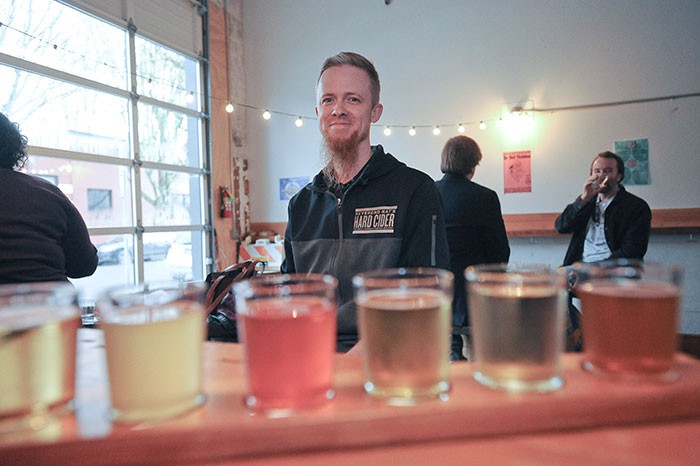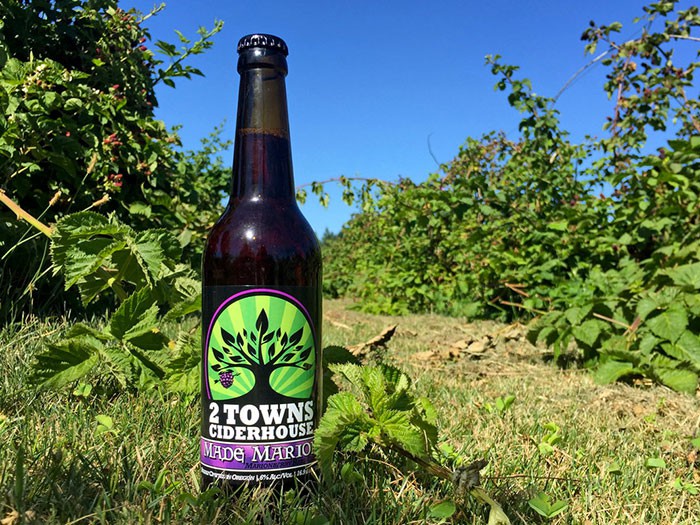Portland Hosts CiderCon—and Embraces a Growing Cider Culture
Article by Brian Yaeger | Featured on Portland Mercury | Image Credits: Portland Mercury or Otherwise Indicated
STEVE JONES, Portland’s most celebrated cheesemonger, cuts off a sliver of Ferns’ Edge Mt. Thielson, a Comté-style goat cheese. Swirling a Wandering Aengus’ Bloom—the Salem cidery’s sweet but not treacly cider—in his wine glass, he says, “That doesn’t suck.”
It’s the Cheese Bar and Chizu owner’s unfussy way of geeking out over his favorite pairings. Not simply this particular cider with this specific cheese, mind you; he and James Kohn, co-owner of Wandering Aengus as well as a board director of the US Association of Cider Makers, are testing a handful of different Northwest-made cheeses and ciders. (Another successful pairing is Southern Washington’s Cascadia Creamery’s Cloud Cap in tandem with Corvallis’ 2 Towns Ciderhouse’s Made Marion. Jones relishes how the cow milk cheese pairs with the berry sweetness and “creamsicles it out.”)
For Kohn’s part, he says that Aengus’ Bloom’s melon-y notes and Mt. Thielson’s acidity are a congruous coupling of fruity and earthy. That’s a far cry better than one of the samples—a “flabby, lactic” Welsh-style cheese—which will most certainly not be featured at Jones’ presentation during CiderCon. The convention takes place at the Hilton Portland and Executive Tower this week (Tuesday, February 2-Saturday, February 6), although access is restricted to those in the cider industry.
Of the estimated 1,000 CiderCon attendees—not just from the Pacific Northwest but the 373 cider companies across the country (including those in planning stages) and some from around the globe—nearly a quarter are expected to attend Jones’ cheese talk. This excites Jones because he firmly declares that, more than wine or beer, cider is cheese’s ideal complement. Tannins cut through the fats. Bubbles scrub away the creamy coating on your tongue.
A flight of ciders served with a cheese board is one thing, but that’s not the main drive behind the current cider boom. By 2014, the cider market accounted for around $400 million according to IRI, a market research company, and there’s still ample room for growth.
And Oregon’s cider market is growing at a breakneck speed. Cider Riot!, which Abram Goldman-Armstrong launched in 2013 in his detached garage in North Tabor, is building a new production facility with around 8,000 square feet. In his first year he made fewer than 15,000 gallons in his garage. He plans to make more than 45,000 next year, and his build-out includes a tasting room with 12 taps.
“I was trying to avoid the ‘oh shit, we’re out of space'” scenario he saw garage-to-warehouse forebears the Commons Brewery and Reverend Nat’s Hard Cider suffer through recently.
Goldman-Armstrong, a fixture of the Cascadian beer and cider scene, grew up in Yamhill County. His annual release of 1763, named for the year of the actual cider riots in Southwestern England in protest of a proposed tax on cider production, is made with estate-grown White Oak Cider orchard apples. That Newberg orchard, established by Alan Foster in 1989, became the first on the West Coast when Foster planted cider varietals like Kingston Black.
The dessert apples you find on New Seasons shelves—such as Red Delicious—don’t create dry, complex cider. And the bitter-sharp apples that have the sufficient sugars as well as acids and tannins for cider making are anything but delicious to eat.
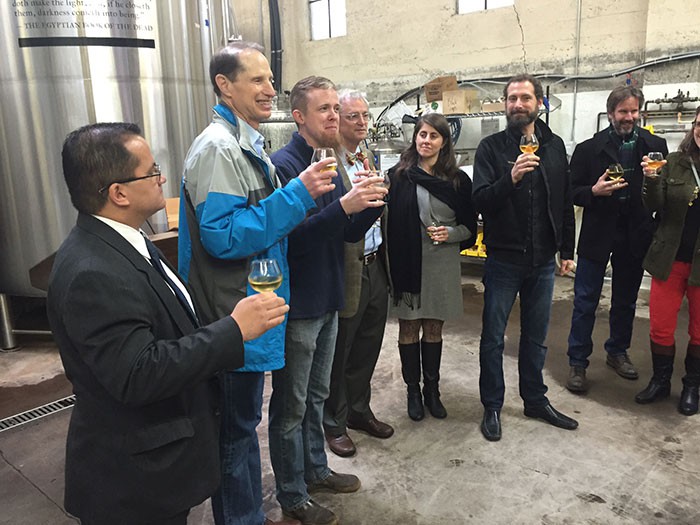
Celebrating the passage of the CIDER act at Rev. Nat’s with Sen. Wyden and Commissioner Blumenauer. | OFFICE SEN. WYDEN
Cider Grapples
While Portland cideries like Reverend Nat’s and Cider Riot! are doubling or tripling their annual production, respectively, there have been two things stymieing if not stunting the cider industry’s growth. One is economic, the other agronomic.
This past December, Congress passed the CIDER Act. Sponsored by Oregon Representative Earl Blumenauer, it stands for CIder Deserves Equal Regulation. Essentially, cider is licensed and made like wine in that it’s fermented fruit, but it’s often enjoyed, like beer, by the effervescent pint. As for excise taxes, it’s caught in the middle. Under seven percent alcohol by volume? Taxed like beer. Over? Cider makers have to pay a much higher tax rate.
The CIDER Act allows for higher levels of carbonation—who doesn’t love tingly bubbles?—but more importantly, it kicks the alcohol by volume (ABV) level up to 8.5 percent, giving producers much more leeway. Since the majority of American ciders are (or will soon be) just under the new excise tax rate, those savings will make cideries more profitable, and they’ll in turn be able to afford to hire more staff.
At a press conference held at Reverend Nat’s Hard Cider following the act’s passage, Blumenauer and US Senator Ron Wyden spoke about the legislation. As Wyden said, it will be a “booster shot for the Oregon economy” as the industry supports not just makers but growers, restaurants, and distributors. Of the bipartisan support the policy received, Wyden said, “We got it done in Washington, DC. How do you like them apples?”
Blumenauer was both staid and sunny. Observing that Oregon is the eighth largest-growing state for apples in the nation, he commented that cider stands for “value-added agriculture,” while the finished product “is an art.” And while it’s certainly a beverage worth celebrating (and celebrating with), the fact that “it’s taxed as champagne is goofy.”
As for how the CIDER Act will directly benefit local cideries, Kohn said Wandering Aengus currently employs 12 people, but if the new law had been in effect last year, “It would’ve saved us $50,000—enough to add a job.” It’s no overstatement to say virtually every cidery is expanding; everyone is or will soon be hiring.
As for the more interesting farming aspect, consumers of the industrially made ciders that advertise on television tend to overlook the fact that cider, like grape-forward wine and hop-driven beer, is an agricultural product. Even though you can buy apple juice from concentrate barged in from China, why on earth would you want to?
As it is, virtually every cidery buys juice, sometimes by the tanker truckload, from companies like Ryan’s Juice in Hood River. In decades past, orchardists gravitated toward more marketable dessert apples, and cider apples fell out of favor. The problem is that even though there’s increased interest and demand for these endangered heirloom and cider varietals now, it takes about five years for an orchard to bear usable fruit.
House Rules
In Forest Grove, Bull Run Cider is one of Oregon’s few cideries with its own orchard. When it started in 2012, the first year’s production was less than 5,000 gallons. Last year, according to co-owner Pete Mulligan, it produced 15,000. That required expanding their production space six-fold, but more excitingly, making use of its own orchard (as well as an on-site nursery) because of the increased demand for apples in a country devoid of a commercial cider fruit industry.
Meanwhile, at 2 Towns Ciderhouse in Corvallis, co-owner Lee Larsen says the company started out of a 1,000-square-foot space in 2010 and produced 30,000 gallons the following year. By 2014, 2 Towns built a new production facility in a 15,000-square-foot space because they’d outgrown the one they built in 2012 (which is still being used for aging, with a 15-tap customer-facing tasting room). The fruit from 2 Towns’ own one-acre orchard just became usable last harvest and accounts for only a small percentage of the 300,000 gallons they made in 2015.
Some folks are taking up the GYI mantle—grown your own—and back at Bull Run in Forest Grove, Mulligan considers the long view. With 4,000 cider trees (and even more being grafted), they’re growing apples not just for themselves but an ever-expanding customer base. He estimates that number will double next year. While they can offer more than 60 varietals, Mulligan says they have 10 growing in their orchard right now. Last year’s harvest, their first, yielded just one acre, some 2,000 pounds of fruit, which gave them four cultivars, such as bittersweet Dabinetts and Michelins.
The folks at Bull Run are always looking to plant more acreage. The local climate, greatly resembling maritime Western England, is particularly conducive to English varietals like Campfields. Mulligan isn’t alone in looking forward to ciders that are drier and have the ideal mouthfeel that cider apples provide, even though today’s market still heavily favors sweeter product.
Once orchards of this size are established, Cider Riot!’s Goldman-Armstrong would like to see them become less hands-on, a problem brought about by our collective obsession with everything being hand-crafted and hand-picked. “The problem with cider,” he begins, “and the reason it’s so much more expensive, is we’re relying on hand labor for harvests. Cider doesn’t need that. The apples don’t need to look good on store shelves. If it gets a bit bruised in the harvesting that’s not a big deal.
“In England and France, they run cattle and sheep in the orchards,” Goldman-Armstrong continues. Relaying a conversation he had with an orchardist in Normandy, France, he says in his best French accent, “They’re a little bit shitty.” He isn’t speaking metaphorically. The fruit that went into a prized bottle of unfiltered, unpasteurized Etienne Dupont Cidre Bouché Brut de Normandie from Domaine Dupont may have been plucked from merde. Goldman-Armstrong then allays American phobias, “They wash it and fermentation will kill it… it’s gonna be alcohol, not fresh juice.”
From Bitter Hops to Bitter-Sharp Apples
Like Wandering Aengus, Cider Riot!, Portland Cider Company, and, seemingly, most cider makers today, Finnriver Cidery in rural Northwest Washington makes a dry-hopped cider. Theirs is made from Finnriver Farm’s bittersweet and bitter-sharp heirloom apples, as well as the Cascade hops the farm managers use for their homebrew.
Co-owner Crystie Kisler says IPA lovers “get it” right away. “We are grateful to diehard beer lovers who haven’t scoffed at cider, but opened their minds, and mouths, and found they like the variety of new tastes that ciders offer.”
Jeff Alworth, a Portland beer writer who wrote the book Cider Made Simple, epitomizes how beer lovers are cider’s primary cross-drinkers. “Beer drinkers occasionally have a pint of cider to mix things up. They relate to cider like they would a new style of beer.”
Alworth doesn’t dismiss the idea that there are dedicated cider drinkers who “are more interested in getting under the hood of cider,” but cider makers certainly don’t object to beer fans who like to dabble.
In fact, “Reverend” Nat West says he talks to brewers all the time. “I don’t talk to wine makers because that’s not my business model.” To be sure, he’s aware that “there are a lot of cider makers across the country who don’t like what we’re doing. They think it’s an aberration and not good for cider. They think it’s diluting the message of cider in America.”
But breweries themselves have received that message, loud and clear. Boston Beer Company, makers of the Samuel Adams brand, introduced Angry Orchard hard ciders, which, thanks to their impressive distribution network, instantly became the top-selling cider brand—commanding more than half of the entire US cider market.
In Oregon, breweries that have already launched ciders include Hopworks Urban Brewery (HUB Hard Cider), Widmer Brothers (Square Mile Cider), Sasquatch (New West Cider), Logsdon Farmhouse Ales (Logsdon Cider), and Rogue. McMenamins, as with all alcoholic beverages in Oregon, was far ahead of the curve, first making cider in 1992.
The concept of dual licenses to make both beer and cider exists nationwide from Two Beers/Seattle Cider Company in Washington State to Harpoon Brewery/Harpoon Craft Cider in Boston. A handful of others are exploring the idea or are rumored to be launching in-house cideries. Soon, 10 Barrel will introduce ciders made by their award-winning brewer, Tonya Cornett, in six-packs; the cider is currently already on tap at their pubs.
Unsurprisingly, the ciders made by breweries tend to reflect their beers. Square Mile comes in six-packs of easy-drinking, refreshing cider made out in Milton-Freewater. Logsdon’s Wilde Appel is an oak-aged farmhouse cider with a funk similar to their Seizoen Bretta. HUB Hard Cider doesn’t have as many organic ingredients as their beers yet, but it’s tart and imminently crushable with a pizza pie.
“I see us as a section of the beer thing the same way as the Commons Brewery,” says West. “They’re non-standard. I don’t make beer, but I’m in the beer world.”
West’s Reverend Nat’s Envy is a dry-hopped cider made in collaboration with hop maestros Barley Brown’s out of Baker City, Oregon. The inspiration came from a triple IPA fest West attended (and stumbled away from), intent on making something akin to a triple IPA in cider form: high in alcohol, high in hops. The result is a 10-plus percent ABV drink that fans of Barley Brown’s Tank Slapper Double IPA would tear into, sweetened with enough juice to replicate the beer’s bodacious malt bill.
“We can capture people’s imagination about the possibility of cider,” West says. Cider is also capturing part of America’s $100 billion beer market. At $400 million, cider is just a fraction of the overall market. And with fewer than 300 cideries currently in operation, compared to the 4,144 breweries, there’s still ample room for growth.
Developing a Cider Culture
Perhaps the best way to glimpse the future of Portland cider—and the cider nation as a whole—is to look where it first took off. In fall 2010, Jeff and Erin Smith opened Bushwhacker Cider off SE Powell. It’s all things cider, from a taproom to a bottle shop to an actual cidery in the back.
“I’ve never been to England. Never been to France,” says Jeff. “I’m glad I haven’t, because I didn’t want to rip off a British [cider] bar.”
While the English, French, and Spanish have noble cider cultures, America’s cider history is tied to the lore of people like John Adams and Thomas Jefferson; like those forerunners, the Bushwhacker pub in Portland’s Brooklyn neighborhood is America’s first bar to go full cider.
Erin used to take great pride in stocking every single cider she could get her hands on. Bushwhacker added rows of coolers. Cider makers had their distributors enter the Oregon market just to get their product into the shop. They carried everything from three percent ABV French ciders to 19 percent Canadian ciders. But they don’t carry everything anymore. There’s simply no way to do that shy of moving Bushwhacker’s Brooklyn outpost from its 1,000-square-foot space into a huge warehouse.
The Smiths recently opened a second Bushwhacker location (901 NE Oneonta) with 2,200 square feet in the Woodlawn neighborhood. While it boasts more taps, there’s a smaller bottle selection and a full kitchen. It’s a fine family destination in North Portland, and the Smiths appreciate how there will be children whose first exposure to cider comes not from the wine-cooler-like beverages you often see at parties, but by sitting next to Mom and Dad drinking proper pints.
Time will tell in what ways the first generation raised on cider will change the face of the industry. But Portland is already the number-one market for cider consumption per capita and draft cider on the whole. It’s no exaggeration to say that the first Bushwhacker pub introduced many to what a cider culture could look like.
Several of Bushwhacker’s customers are now players in the industry. Jeff recalls going over designs for Reverend Nat’s labels with West. And the Oregon/Washington Cider Collective is a brand-new cider maker in Milwaukie whose Mosaic Pippin is a revelation for hopped ciders; their experimentation led to the simultaneous release of three plum-infused ciders.
Even on a national level, the Smiths count cideries and cider bars from Vermont to Indiana among the businesses founded by their early customers—and even, in one case, a bartender. Sarah Williams used to serve cider to Kolin Leishman, a pomade and mustache wax salesman. The duo formed Northwest Cider Brokers in 2013, where they work with growers and producers.
Expect both Bushwhacker pubs to be slammed this week during CiderCon. The annual conference is usually held in Chicago, but starting this year it will be hosted in a different city every other year. There’s already talk of Seattle hosting in 2020. The face of this still-young industry will look vastly different by then. And attendees are coming to Portland to get a taste of what that might look like.
“Just as Cascadia led the craft beer movement and consumption,” says Goldman-Armstrong, “it’s the same with cider. We have a prevalence of embracing it, not just the mass-market stuff… due to the openness of people’s palates. We make dry cider that isn’t back-sweetened beyond belief.”
Writer Alworth is a bit more wary, but has faith in local consumers. “Once the gimmick wears off, drink companies have to invent a new gimmick. I’m worried that the cheap supermarket ciders, which taste like liquid Jolly Ranchers, are turning potential craft cider fans away before they ever get to the good stuff.” But he tempers his concern with optimism. “More than most places, in Portland people get that if you start with very good ingredients and a craftsperson’s approach, you make a formerly industrial beverage saturated with flavor and interest.”
At Cider Riot!, they make a cider called Opal using a single varietal of apple—Opal from Washington State—and Opal hops from Germany. It’s cider nerdery at its finest. And both Bushwhacker and Reverend Nat’s have discovered that Mountain Rose heirloom apples from Hood River—which bear a gorgeous shade of flesh between guava and magenta, and an equally beautiful flavor with notes of strawberry-basil salad—translate into an illuminating drinking experience.
As West says, “We can capture people’s imagination about the possibility of cider. As well as: What is cider?”
Isler Northwest LLC is a firm of certified public accountants and business advisors based in Portland, Oregon. Our local, regional, and global resources, our expertise, and our emphasis on innovative solutions and continuity create value for our clients. Our service goal at Isler NW is to earn our clients’ trust in us as their primary business and financial advisors.
Isler Northwest
1300 SW 5th Avenue
Suite 2900
Portland, Oregon 97201

